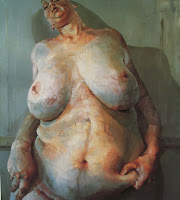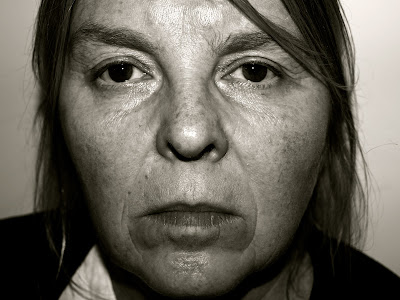Exploring the Ways in Which Artists Portray Women in Their Work
 |
| Judy Chicargo - Birth Tear |
The art world has gone through many changes over the centuries; one of the most critical movements was 'The Feminism Movement', it particularly influenced me and my art topic, ‘The Self Portrait’. The feminism art movement did not just occur, it had been building up for quite some time. It all started in the 1900's when the first wave of feminism happened, this was the right for women to vote, after much protestation woman were granted their wishes. After effectively accomplishing their proposal this gave women the confidence to carry out more feminist acts. As the 60s came, the 'Women's Liberation Movement' happened, where they were looking for legal and social equality, this caused the 'girl power' craze. This is when the feminism art movement started, with a famous article with changed the art world; 'Why Are There No Great Woman Artists?' in 1971, this sprung up many issues within the art world and caused people to actually start to look at women's art work in a professional manner. It was then only 5 years later, the first woman's art museum and from then on woman have been expressing themselves through artwork, The typical feminist piece of work would consist of vaginal imagery, menstrual blood, naked woman with a lot of embroidery ('women's work'), a perfect example of this is Judy Chicargo's 'Birth Tear'.
 |
| Jean Auguste Dominique Ingres- La Baigneuse |
Many centuries ago women weren't even allow to paint, as it was seen as academic, and only men were allowed to indulge themselves in education, so through the renaissance period, paintings were painted from a mans perspective and were for men. The occasional time a woman would paint, it would be in honour of a man, it would be a self-portrait of them holding up a painting of the man they are honoring. So through the 1300-1800 we saw many similar paintings of nude women, although they might be in different styles the woman would always be represented in the same way. The painting of nude woman would usually be small, elegant, with their face looking away or looking vulnerable, with the woman lying down as if helpless. Typical artists of these paints are Jean Auguste Dominique Ingre and Raphael. So when the feminism art movement came it was huge shock to the system for many male artists and what was once their domain, had suddenly been taken over by many woman.
 |
| Jenny Saville - Branded |
Now art is full of inspirational woman portraying the 'real' woman. I felt I wanted to achieve this within my art, and portray the real side to mothers and the way their children treat them. I looked into a few of these women in my spare time and sketch book to get a clear feel for their art and meanings behind it. One artist which really interested me was Jenny Saville who reinvented the self-portrait, by showing how she really saw herself, and how women are not usually portrayed. She fights the idea of the perfect body, by showing them enlarged and distorted. I felt I wanted to do the same thing with mums, and show a 'real' mum who isn't a perfect 'yummy mummy', I didn't want to show the stereotypical mum, as Saville didn't want to show a stereotypical woman, she shows this in her painting 'Branded', where she has an obese woman with words like 'petite', 'delicate' etc. Branded on her skin. I also wanted to show my effect on my mum, by making her into a puppet, as if I were the puppeteer. Saville made various enormous paintings of obese woman which are really in your face, as if the bodies are pushing out off the canvas, this contrasts with most portraits of small, elegant woman. I also feel it's prominent because she is trying to show how skinny women in media and advertising are being drummed into our brains. Jenny Salville's work is known for being feminist, and she was one of the artists who participated with 'The Feminist Movement', on one of her paintings she inscribes:
"If we continue to speak in this sameness, speak as men have spoken for centuries, we will fail each other again."
 |
| Sarah Lucas -Au Naturel |
Another feminist artist who I researched into was Tracey Emin, who was a founder of 'confessional art', she portrayed her deepest thoughts and secrets though her art. One of her most famous pieces is called 'Everyone I Have Slept With', which was a tent with the names of everyone she had slept with sewn onto it, many feminists use sewing within their artwork, to be ironic as sewing is 'woman's work'. Throughout my sketchbook I introduced sewing to give it texture, and emphasis to my mum being a typical mum. Emin's confessional work like 'my bed', where she shows her bed with all her mess around it, beds are very personal places which only a few selected people would see, I feel it also shows that woman are not perfect and can be just as messy and dirty as men, this inspired me to confess how I use my mum as a puppet and how I see her, not how she would like people to see her. An artist who's work is similar to Tracey Emin is Sarah Lucas, in her work she represents sexuality in a jokey stereotypical form, a famous piece of her work is 'Two Eggs and a Kebab', many people use these words when talking about woman's body parts, so she lays them out on a table where the actual body parts would be, it has a great comic effect and really makes the audience think about the slang we use to describe a woman's body. Lucas's work can be quite blunt, when representing a man penis, she just uses oranges and a cucumber, she does this because she is almost mocking, old painters who painted woman with fruit, for example Gauguin and Piccaso.
Throughout my sketchbook I explore Diane Arbus, she was a huge impact on my work. She is known to photograph 'freaks' in their natural habitat. She doesn't glamorize them, but instead captures 'the space between who someone is and who they think they are'. I tried to take some photos of people in the style of Diane Arbus, by trying to show their true self, I tried to capture the eery feel her photos have, this lead me onto my final piece, by showing the truth behind someone, and the effect other people have on them. My mum would never like to think I have control over her and that she spends most of her time cleaning and cooking, she would never like other people to know this, Arbus's work 'implicates you and the ethics...our license to have that experience of viewing another person is changed and challenged'. I wanted my work to quite intimate, and for the spectator to be involved and understand the meanings behind it.
 |
| Cindy Sherman - Untitled Film Still |
Another photographer who interested me was Cindy Sherman, who raised challenging questions about the role and representation of woman in society and media. she provoked thought into the stereotypical image of a woman, some of her photos showed woman being pristine and neat, but then has the complete contrast, photos of vulnerable girls, from a high angle shot looking frightened, as if the spectator was the violating the woman. This could be emphasizing that most woman hide behind a facade, and no one really knows what's deeper, this was very relevant before the 'Woman's Art Movement', because it was common for woman to keep their feelings and thoughts to themselves, so men didn't seem to understand woman and the complexity of them. Now due to the 'Feminist Movement' woman are far more honest and open about the their opinions, and men now understand woman to a certain extent.
From all my research I have got a clear understanding of the 'feminist art movement', which gave me inspiration throughout my sketch book and for my final piece. My aim of my final piece was to portray the most influential person in my life, my mother. I wanted show the viewers, how I see my mum and my influence on her and her surroundings, I intended to include 'confessional art' as the main inspiration, as I am confessing I use my mum as marionette, and I can manipulate her to do anything. I felt it also showed the true side to mothers and their day to day lives, how they are slaves to their own children. This tied with the 'feminist movement' as woman were second class citizens and were rules my men, but nowadays it has changed from men to children. All of these artists help get and idea of what 'feminist art' is all about, and the meanings and representations behind them. I found all of these artists inspired me to do a reflection of myself on my mum.







































